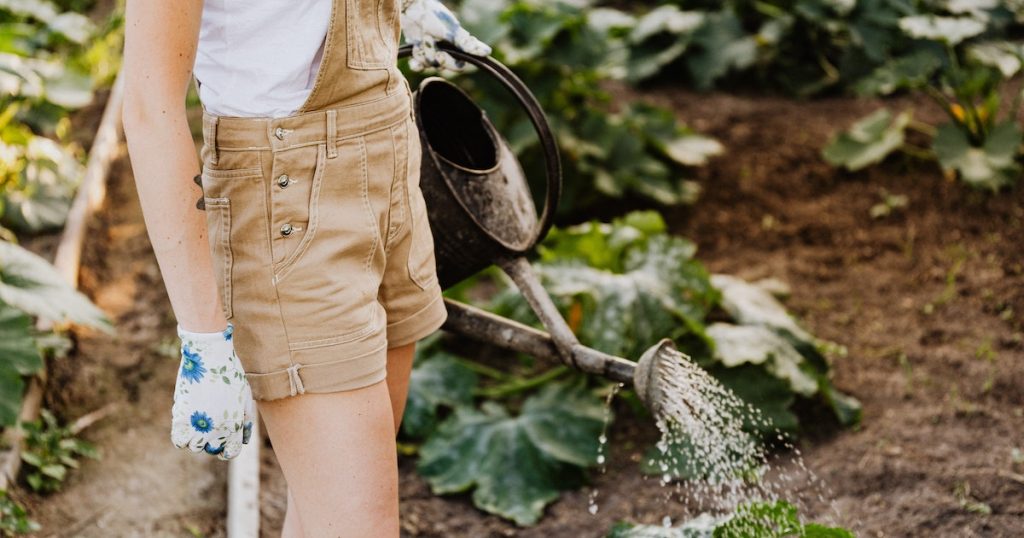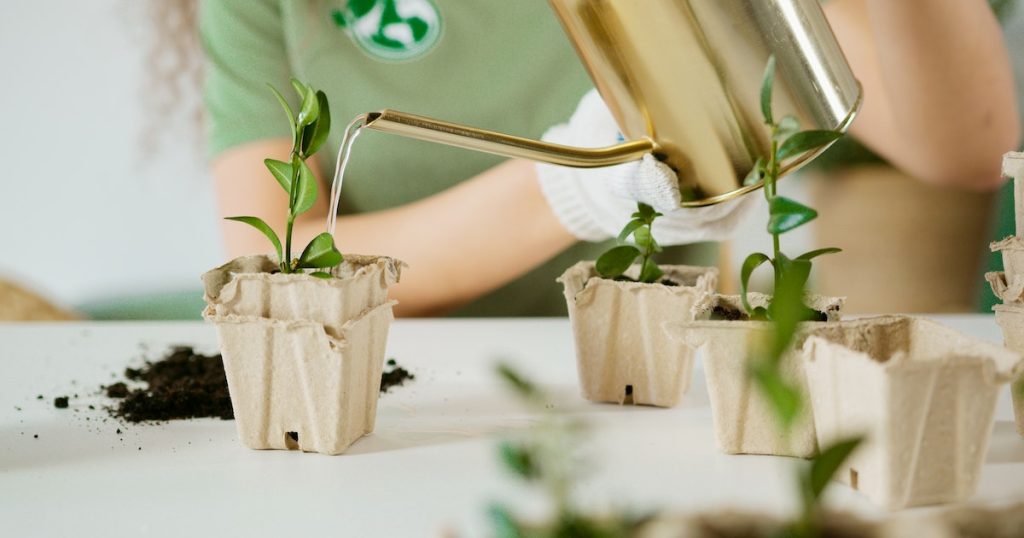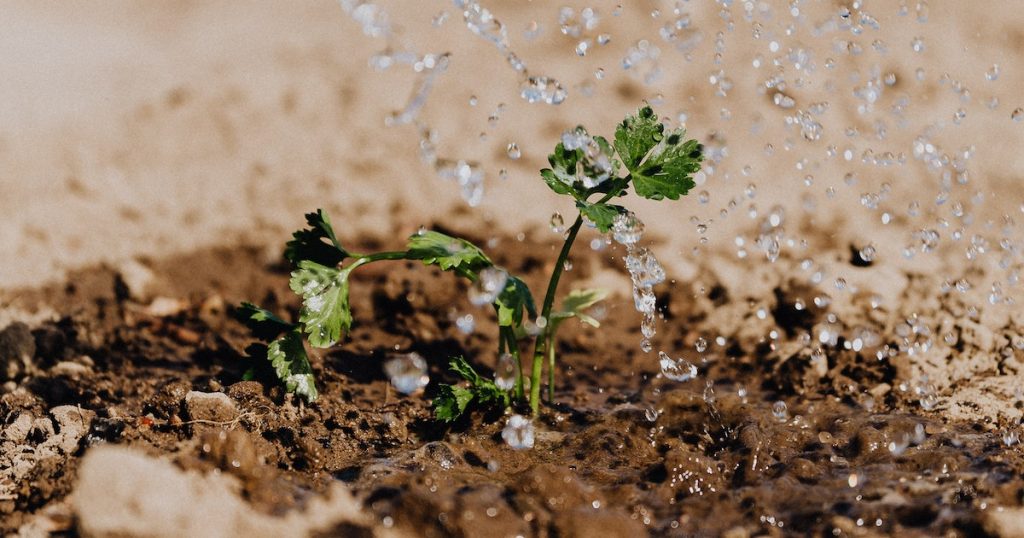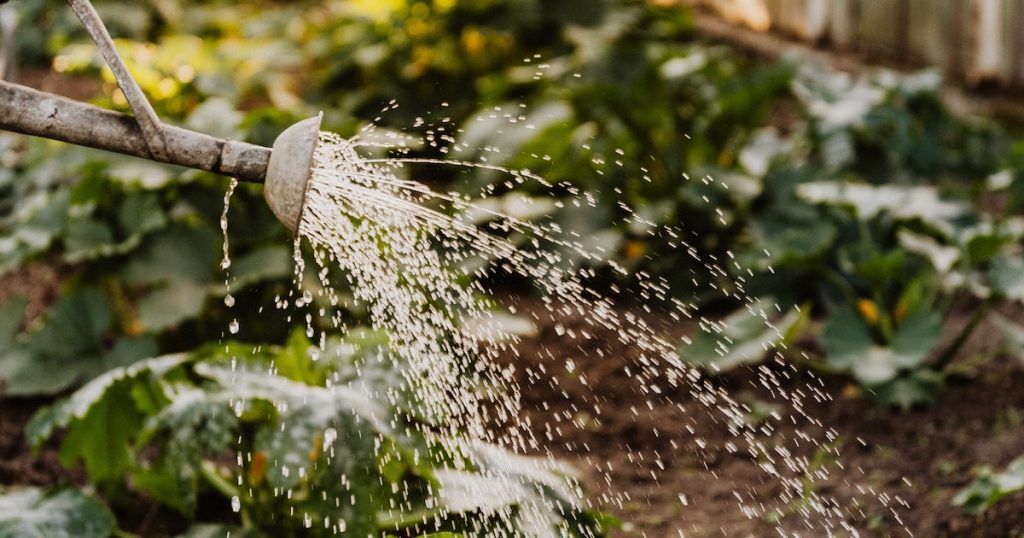Potting soil is one of the most crucial elements in growing a successful container garden. Your plants will suffer if your soil is not soaking up adequate water. If you’re wondering, “why is my plant not soaking up water?” we’ve done some study on potential causes and solutions for such problems.
The reason your potting soil isn’t absorbing water is either that the plant is root-bound (too big for its pot), you didn’t use an adequate amount of water, or you failed to add any at all, or the peat has dried up, and it is no longer able to soak up water. Use a wetting agent (surfactant), water the soil, or add an organic component to remedy the issue.
Continue reading to find out more about how your potting soil could have gotten to this point and what you can do to help it regain its ability to hold moisture.

Table of Contents
Why Is My Plant Not Soaking Up Water?
You’ll probably need to follow a simple method of reduction to figure out why your potting soil isn’t absorbing water. To do this, test out several solutions and look at how well they work to rule out potential underlying reasons.
As was already said, there are several reasons why your soil may not be absorbing water. Think about the following:
The Plant Is Root Bound
When a plant gets root bound, it is a sign that it has outgrown its pot. The plant’s deep roots enable it to absorb the water you liberally pour into the container. As a result, the soil won’t be able to soak up enough water.
You need to transplant your plant into a container that is the right size to fix this problem, or you may gently prune your plant. Either solution will work, but because the soil will not be able to absorb the water, your plant won’t be able to grow in its current condition.
You Did Not Use Enough Water
You can make the error of initially giving insufficient water to the potting soil, regardless of your experience level with caring for plants and whether it’s something with which you are somewhat more familiar. The soil will then obviously look barren.
If you think this could be the issue, consider adding a little bit extra water while taking care not to overfill the container. Furthermore, avoid overwatering your plants to prevent root rot and waterlogged plants. Just keep adding little amounts until you see a difference in how the potting soil absorbs water (or not, meaning you can move on to your next solution).
You Failed To Add Any Water
In addition to not providing sufficient water while attempting to water your plants, neglecting to do so at all is nearly always a problem. Almost all of us lead hectic lifestyles; therefore, there may be a few days when our attention is not focused on our indoor plants (regardless of how much we love them).
If you don’t give your plants enough water, you’ll notice that the potting soil seems dry. Maybe you could think about keeping a calendar at your house to record when you watered your plants, especially if you have a lot of plants that need varying levels of watering during the week.
The Potting Soil’s Peat Has Dried Out

The peat in the potting soil will probably dry out if you forget to hydrate your plants (or, let’s say, if a major life event occurs and makes you unavailable to your cherished plant companions). Unfortunately, this peat finds it quite challenging to start absorbing water again when this happens.
As a result, you can completely replace the soil (particularly if it has been a while since you forgot to hydrate your plants, but they are still somehow surviving). Alternatively, you may think about adding water to the soil through another method, such as by constructing a trough or melting ice cubes on top of the soil to promote slower absorption.
It’s crucial to take into account the particular factors that lead to your potting soil losing its ability to absorb water while trying out your different solutions using the method of elimination. These are unmistakable indicators of why it is so difficult for you to maintain wet soil for your plants.
What Is Bottom Watering?
An alternative to traditional top watering in irrigation is bottom watering. The plant is positioned in a 1 cm-high container of water. For 15 to 20 minutes, the plant is left to sit, allowing the water to percolate up the soil by capillary action. The soil gradually becomes damp at the water’s top location.
The plant is then removed and given time to drain any extra water after the allotted period has elapsed. Bottom watering completely avoids the issue that soil presents when it takes forever to soak up water from above. Even though this may temporarily solve the issue, you should still check into why the soil isn’t absorbing the water.
In addition to using bottom water, misting may be used to raise the humidity level surrounding the plant. The plant absorbs water via its leaves when misted, which enhances humidity.
If nothing else works and you’re still wondering why your plant is not soaking up water, this method is guaranteed to solve your problem, allowing you to return to your regular watering schedule.
How To Fix Hydrophobic Soil Houseplants?
You may have discovered the cause of your potting soil’s inability to absorb water, but what should you do to fix it? There are several options available for you to think about. These will assist in resolving a wide range of problems that may be preventing your potting soil from absorbing water for a variety of reasons.
Think about the following solutions to fix soil that does not soak up water:
Add A Wetting Agent (Surfactant)
You might be able to rehydrate the potting soil that has unluckily dried out by using a wetting agent, often known as a surfactant. But it would need some effort.
Add several drops of a wetting agent to every gallon of water to accomplish this (or use the measurement written on the label, if any). Next, pour this solution into the container’s midpoint. Be careful not to pour it too close to the edge, as this might cause the water to spill over or the dried-out soil to be unable to soak it adequately.
The majority of places that sell plants, like home goods merchants, gardens, etc., also sell wetting solutions or surfactants. Use a homemade substitute, like liquid dish detergent, sparingly as an extra alternative. You can repeat this procedure as often as necessary if it takes some time to see any benefits.
Here’s a comprehensive video on how to fix hydrophobic soils using wetting agents:
How To Add A Wetting Agent
Put the soil into a watertight container, and then soak it.
If you have the choice to extract the soil from the pot without injuring the plants, you should do so. Alternatively, if the soil is in a waterproof container, you can saturate the entire container and the plant.
This works best if the dirt can be completely removed since you can rejuvenate it and work in the soil using your hands without hurting the plants. If the soil is exceptionally dry and the peat has been allowed to dry out, you might notice that this process takes some time.
Give the water a little more time to settle after the soil starts to absorb it. After you see that virtually all the water has become soaked, you may work with the soil like you would when shaping bread dough, gradually splitting any clumps left behind and ensuring that the moisture is evenly distributed.
Add Compost Or Organic Compounds
You can add organic compounds or fertilizer to the potting soil to make it more fertile if you can remove your plants from the mixture or are certain that the materials won’t hurt your plant.
If you choose this alternative, use caution because it calls for deft handling if you wish to apply the mixture close to your plants. Either way, you can use compost from your garden or a naturally wet substance like manure. Add little by little until your soil seems to be absorbing moisture once again.

Apply A Slow-Absorption Technique To The Soil
In the center of your soil, create a tiny hole and fill it with water. This will push the water to soak into the container’s center instead of naturally flowing toward the edges.
Make a small hole in the middle of your soil and fill it with water to construct a water well. If you do this, the water will be forced to seep toward the middle of the container rather than naturally flowing toward the sides of the container.
How To Improve Potted Plant Drainage
Following are some of the ways you can improve plant drainage to avoid a waterlogging issue.
Check the Soil and Change the Mixture
There may be more clay in the soil than is now in the plant pot, which might be the cause of the water not being soaked into the soil. Since clay particles are more closely spaced out, watering it might result in water stagnation, which causes waterlogging.
If water is resting upon the soil’s surface and isn’t being absorbed, the soil may be hydrophobic, as was previously said.
Create Drainage Holes In Your Container
Any plant container must have drainage holes. It offers a channel for extra water to drain from the container. Without drainage holes, water will eventually collect inside the soil, resulting in waterlogging.
Furthermore, this might result in issues like root rot, which could injure or even kill the plant. In a typical plant pot, there are four drainage holes, each of which has a diameter of between an inch and an inch-and-a-half.
Additional preventative measures, like a filter material to hold the soil in place when water is draining out, may be needed. Wider holes may also enable dirt to exit the plant pot with water.
Use A Chopstick To Aerate The Soil Manually
Aerating the soil manually involves giving it a little air to help avoid soil compression. The supply of oxygen to the plant’s roots, where it is required, is increased once the soil is aerated. Additionally, it improves soil drainage by creating holes between soil particles so that water may soak in and then flow out of the plant container.
Although some roots may be injured, the plant will not die, as it would if the soil were to stay compact, which would ultimately smother the whole root system.

Incorporate Soil Additives
You should add soil amendments to the potting soil to improve drainage. Substrates like perlite and vermiculite can be used as soil additives. When it comes to drainage and soil aeration, they both perform admirably. To generate a perfect mix for drainage and oxygenation, add perlite and vermiculite in a 1:1 ratio, which will also account for 30% of the total volume of the soil additive combination.
This is a proven method to revitalize potting soil that has been used or is just resting for a while, improve drainage, and provide extra nutrients. Amazon has a perlite and vermiculite blend that is affordable for all your potting requirements.
Use Rocks for Better Drainage
It is common practice to promote soil drainage and aeration by adding a layer of pebbles to plant pots before adding soil. Apart from creating holes at the bottom, potters typically use rocks to raise the plant saucer well above the soil surface such that water may flow out of the soil and not pool at the bottom and cause a waterlogging issue.
Final Thoughts
We hope that we can help solve the issue of “why is my plant not soaking up water?” At first, this can be a worrying occurrence, but as with many plant-related problems, the faster you identify and resolve them, the better your chances of saving the plant are.
Recent Posts
Have you found yourself wondering, 'why is my bamboo growing so slow?' Despite the fact that bamboo plants are remarkably fast-growing, it can sometimes take months (or even years!) to see any signs...
Miracle-Gro is a huge help when you are trying to get decent yields out of your plants or if you want them to thrive. However, you may have noticed that a single dose of fertilizer does little to...
